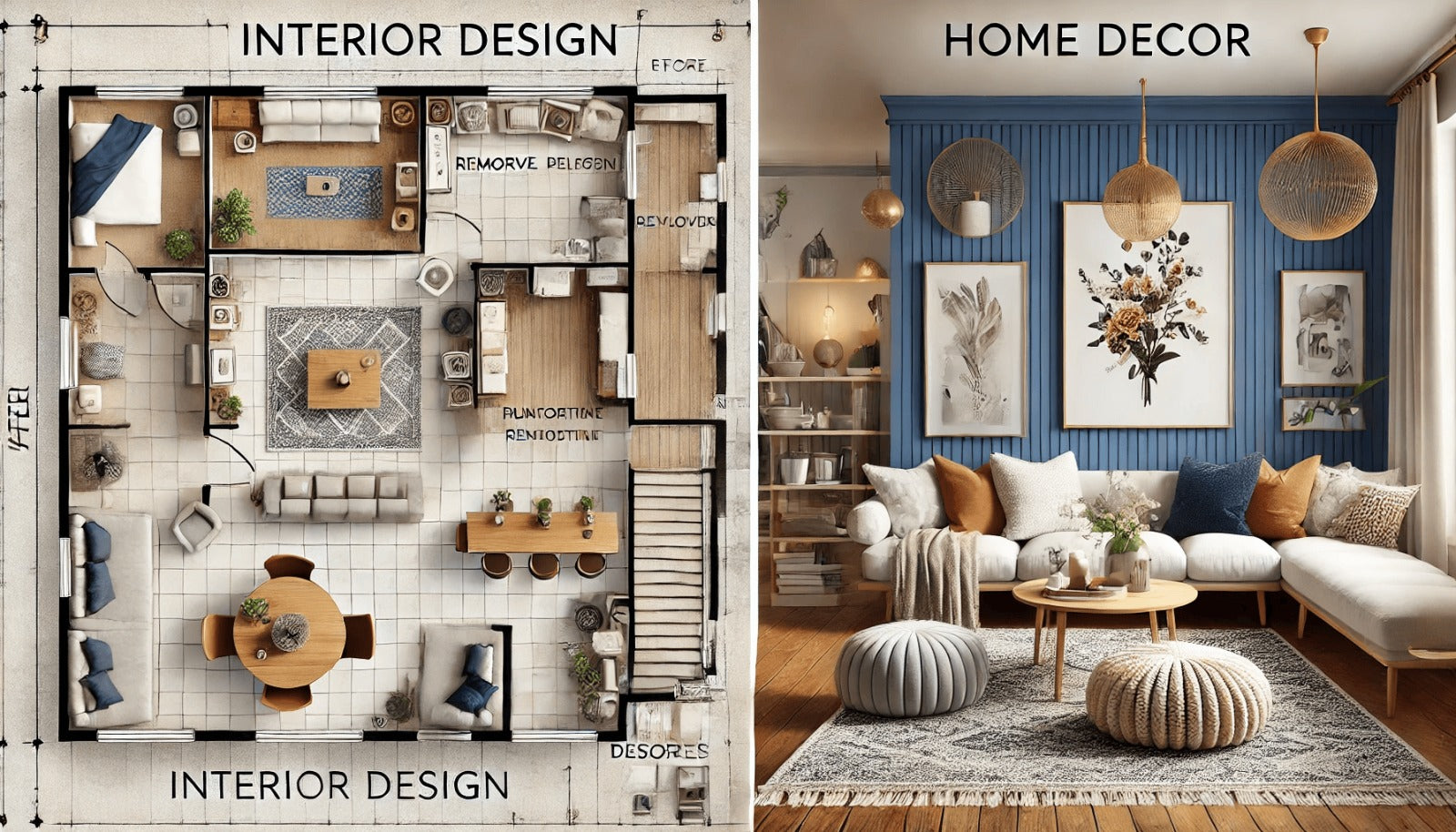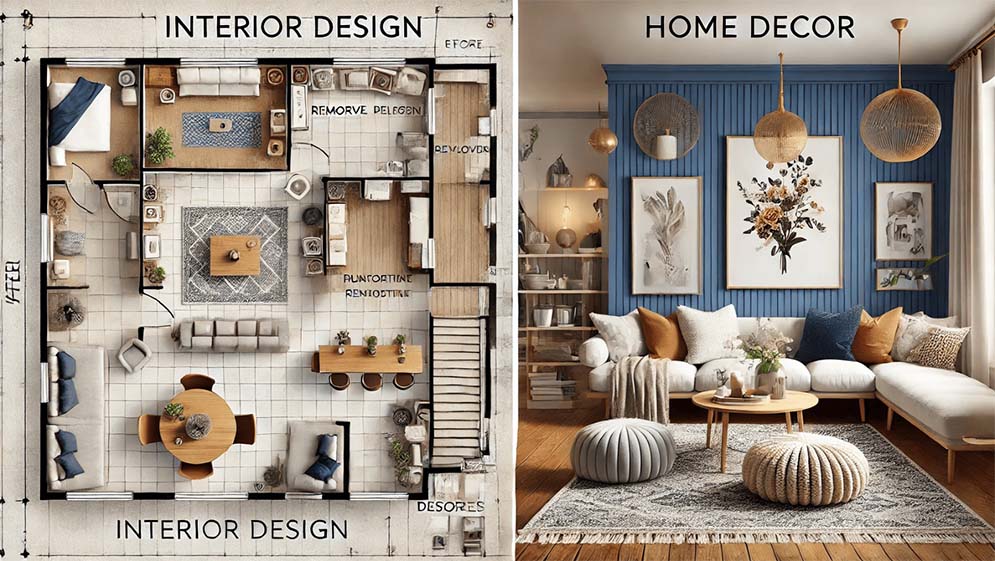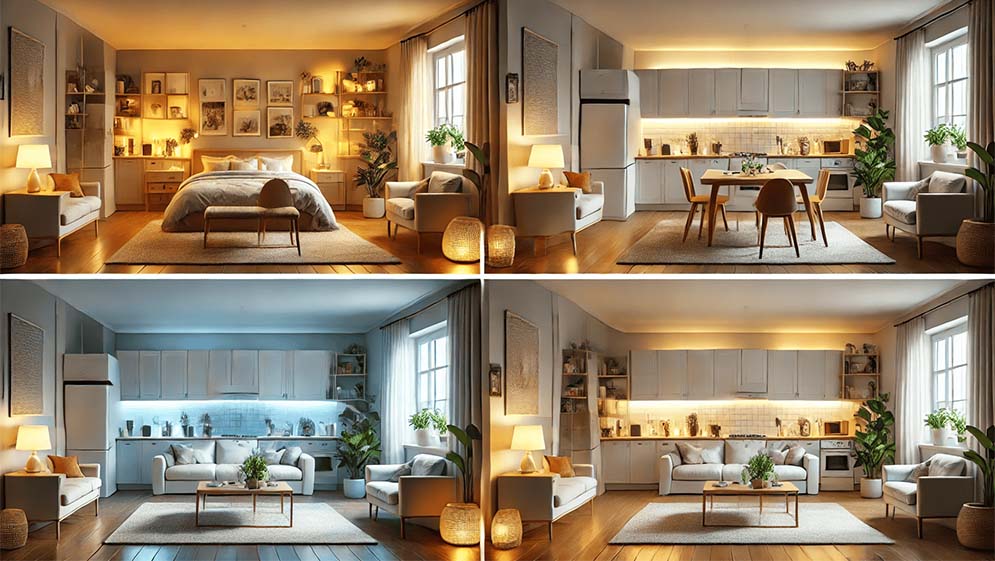If you are planning to change the look of your home, it is important to know that the distinction between home and interior decoration is vital. Though these terms are commonly employed interchangeably, they are distinct aspects of creating a comfortable and efficient living space. This article explains the specifics of each to help you make educated decisions for enhancing your house.

Defining Interior Design
Designing interiors is the practice of preparing and designing visually appealing and functional areas within buildings. It involves the combination of design theory, architecture, as well as technical expertise to improve a space's layout functionality, as well as overall aesthetics. The aim of interior design is not only to create a space that looks attractive, but also to make sure that it's efficient as well as comfortable and functions efficiently for the intended purpose.
1. Functionality and Layout
Interior design transcends aesthetics, it is focused on maximizing the utility of an area. Designers take into consideration the intended use of each space and arrange their layout in accordance with this function. As an example, a bedroom is designed to relax and sleep, which is why your layout should be geared towards relaxation, while a house office is designed to be ergonomic as well as organized.
Interior designers are skilled in spatial design. They are aware of circulation, the zoning of spaces within a space, and the way furniture and other components are integrated. A designer for interiors will make sure that the area isn't simply pleasing to the eye but also functional.
2. Structural Changes and Renovations
One of the major differences of interior design is the possibility of structural changes. Although home decor is focused on the aesthetics of an area, Interior designers can modify the layout of the area for better design and function.
Interior designers typically work with contractors and architects in order to change layouts, remove walls, put in new windows, and even alter the arrangement of rooms so that they can meet the demands of the homeowner. A good example is making a living space open through the removal of barriers between kitchens and the living area is an important task for the interior designer, not only the decorator.
3. Technical Knowledge
Interior designers are experts regarding construction codes, safety requirements, as well as how different furniture and materials will impact the area. They often are engaged in the selection of the flooring, wall coverings, as well as furniture and lighting fixtures that meet security regulations and can endure in the setting in which they're designed.
In particular, designers are likely to consider aspects like security from fires, accessibility for disabled people, as well as the longevity of the material. Additionally, they will be acquainted with the technicalities of plumbing and electrical wiring when making a design.
4. Lighting Design
Lighting is an integral part of the interior design. Interior designers are proficient in making use of artificial and natural lighting to improve a space's practicality and ambience. They look at various elements, including the dimensions of the space and the amount of sunlight that it gets, as well as what the area's purpose is, in order to design a suitable lighting strategy.
In the case of a designer, for instance, they may choose to use softer adjustable lighting in a living space to provide a warm and inviting environment, while bright focused lighting could be utilized in the kitchen or at a home office. Lighting fixtures selection and their location are key elements of design for interiors.
5. Integration of Design Elements
Interior designers incorporate design elements like furniture colors, patterns, and décor to create a coherent plan. They look at how the elements work with regard to style, materials, design, and functionality. It is important to create environments that are attractive as well as practical for daily use.

Understanding Home Decor
Decorating your home is a term used to describe the aesthetics of the space, including how it's decorated, furnished, and accessorized. Interior design encompasses more of a range of concerns that include the design, layout, and function of a space. The home decor focus is mainly on the aesthetics of a space. The goal of home decor is to make a beautiful setting, which often reflects the personal style and character of the homeowner.
1. Furniture Selection
Furniture is among the primary factors in home decoration. Furniture selection is not merely a way to define the design of the room, but also adds practicality and comfort to the room. The home decor focuses on picking the appropriate pieces that fit in with the design and style of your room. This includes everything, including chairs and sofas, cabinets and tables.
In contrast to interior design, which concentrates on the layout and purpose of furniture, decorating for the home involves choosing furniture that will enhance the appearance and feel of your space. As an example, you could select a contemporary couch for an open-plan living space or a traditional wooden table for an edgy space.
2. Color Schemes and Patterns
Decorate your home with the use of patterns and colors. A well-chosen color palette can change the look of a room, creating a mood throughout the space. If you're looking to create a tranquil ambience with soothing blues or invigorate the space using bright reds, decor experts are focused on finding the ideal combination of colors that will suit the preferences and tastes of homeowners.
Alongside color, patterns are an important aspect of decor for homes. Designs in fabrics like rugs, cushions, as well as curtains can bring depth and appeal to rooms. Decorators at home select patterns that are harmonious with the overall style of the space.
3. Decorative Accessories
The home decor includes accessories that lend the space character and style. The decorative objects include cushions, artwork, vases, as well as lamps and rugs. The home decor is about adding finishing touches to your home that enhance aesthetic appeal and help give a room a personal touch.
Hanging artwork that is stunning in the room or putting some unique flowers on the table will help a room appear full and welcoming. The decorative items might not be very functional, however, they can greatly impact the atmosphere and mood in a room.
4. Textiles and Fabrics
Interior decors place a huge focus on fabrics like curtains, cushions, bedding, as well as upholstery. They not only enhance the aesthetic appeal of the space, but they also increase the comfort. A velvet couch or soft wool rug could add a touch of an element of warmth, texture, and an air of luxury to an area.
As interior designers pick textiles based on their functionality and longevity, interior decorators are focused on the appeal and aesthetics of the fabrics, selecting materials that are in harmony with the theme, color scheme, and general style of the space.
5. Art and Wall Decor
Wall decor and art are among the most noticeable aspects of home décor. Wall art, be it pictures, paintings, or even mirrors, will transform the way the room looks. Decorators choose art that complements the room, which helps to define the atmosphere and feel of the room.
In contrast to interior design, which is focused on fundamental elements such as lighting or furniture arrangement, home decor concentrates on enhancing the interior with items that hold symbolic and emotional significance.

Key Differences Between Interior Design and Home Decor
|
Aspect |
Interior Design |
Home Decor |
|
Focus |
Function and design of the room. |
Accessories and elements to enhance the aesthetic impact. |
|
Involvement |
It could require major structural changes as well as remodels. |
The design is not structurally altered, and focuses on finishing the details. |
|
Professional Role |
Education is required in formal schooling, as well as an understanding of building codes and safety rules. |
There is no formal qualification required. For more information on style and imagination. |
|
Goal |
Make functional, efficient, and attractive areas that are functional, efficient, and visually appealing. |
Design a room that is visually appealing by using stylish components. |
|
Scope |
More extensive scope of lighting, furniture, layout, and much more. |
A smaller scope that focuses on accents for decoration, textiles, and color. |
|
Skills Needed |
Understanding of lighting, architecture, and spatial planning materials. |
The ability to think creatively when selecting and creating the look of furniture, colors, and even accessories. |

When to Hire an Interior Designer
Consider hiring an interior designer if your project involves:
- Renovations or structural modifications.
- Making a design that is cohesive and covers many rooms.
- Building codes, regulations, and building standards.
- The design of spaces that have specific purposes, such as offices or kitchens.
A professional interior designer has the experience to create spaces that function well and are visually pleasing. This is done by making sure that every element functions seamlessly.
When to Hire a Home Decorator
An interior decorator can be ideal for:
- The look and feel of the room have changed.
- The selection of furniture, colors, and other accessories that match your personality.
- Style spaces to celebrate the seasons, or to celebrate special occasions.
Decorators concentrate on the final details that can personalize an area and make it feel unique and personal to you.

FAQs
Do I need both interior design and home decor services?
The truth is that interior design and decor usually are able to work in tandem to create an appealing room. Interior designers will ensure that the space is efficient and organized, as well as home decors add the final touches to enhance the look of the room.
Can I decorate my home without a designer?
Absolutely! A lot of homeowners decorate their rooms themselves by choosing furnishings, colors, and other accessories that express their own personal taste. But if you're planning to alter the structure of your home or require expert guidance on design, a professional interior designer may be of help.
Can home decor be changed easily?
The truth is that decor for your home can be more easily changed as opposed to furniture or other design elements. It is possible to swap the pillows, rugs, or even artworks to update the look of a space without having to make drastic changes.
What’s the best approach if I have a small space?
For small spaces an interior designer will assist in maximizing the functionality of a space through the use of a strategic layout and furniture that is space-saving. To decorate the home, select light colors, furniture that can be used for multiple purposes, and other accessories that help create a feeling of open and spacious.
Is interior design more expensive than home decor?
In general, interior design may be more costly because of the complexity of the task involved, particularly when it involves significant renovations or structural modifications. Interior decor is typically cheaper, since it is focused on styling and accessories.
How do I choose between hiring an interior designer or a decorator?
If you require assistance with layout, functional as well as structural modifications, an interior designer could be an ideal choice. If you're seeking to improve the look of your home by incorporating furniture, colors as well and accessories, a professional home interior designer can assist you in achieving the vision you have.
Conclusion
In conclusion, both interior design and home decor strive to make visually pleasing areas, however, they differ in the way they approach it. Interior design involves planning for functional purposes as well as spatial arrangement and structural adjustments to assure the safety and effectiveness of your home. This requires expert knowledge in the field of architecture as well as technical considerations. Interior decor, in contrast, is focused on style by selecting colors, furniture, materials, and other items that express your individuality.
If the project you are working on requires layout modifications or conformity, the services of an interior designer are an ideal choice. To update the aesthetics as well as add class, an interior designer is an excellent alternative. Being aware of these distinctions can help to make educated choices, making sure your home is stylish and useful. If it's your home office or living area, the right expert can assist you in achieving your ideal appearance.




